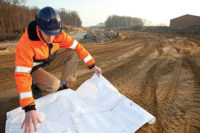
When it comes to fulfilling OSHA 1910.146 obligations for designating a confined space rescue team, choosing the local fire department might seem like the easy way out. But this option is not as simple as you might think. It’s more than a matter of knocking on the fire department door and handing them a notice saying that they’re now your rescue squad, or writing “call 911” in your confined space plan.
If a confined space emergency occurs and the responding fire department is not adequately equipped or prepared to carry out an effective rescue, not only are your workers’ lives at risk, but you can be fined for any OSHA violations, according to confined space experts. It’s your duty to make sure your rescue squad is fully prepared prior to any emergency, they say.
Few and far between
A relatively small percentage of fire departments are actually qualified to perform confined space rescue, according to Craig Schroll, CSP, CET, a leading authority on confined space safety and president of the consulting firm, Firecon. Budgetary limitations or staffing issues may make it impossible for a department to obtain the proper equipment, training or personnel to perform rescue operations. In this case, companies can sometimes provide funding to help a fire department develop confined space rescue capabilities, say experts. But there are other potential limitations to consider.
A volunteer department may be unable to respond quickly enough to meet the requirements of the confined space standard. Or a qualified department may be located too far from your facility to ensure a timely response or might cover such a large geographic area that response time and availability could be concerns.
A look at liability
Even fire departments qualified for confined space rescue sometimes are hesitant to agree to be a designated responder because of liability issues, says Schroll. Experts agree that when outside responders are used for rescue operations, liability becomes a gray area. If the fire department responds to an incident in a federal jurisdiction and there is an OSHA violation, odds are that the company will be cited for failing to ensure that the responder was able to perform the job adequately, says Schroll.
However, in “state plan” states, where job safety is enforced at the state level, the fire department could be cited directly, he says. According to OSHA, 22 states/jurisdictions currently have complete plans (which cover both private and state and local government employees), and four states/jurisdictions have plans that cover only public employees.
A fire department has the right to refuse to act as a company’s designated responder, according to confined space experts. This does not mean that the fire department wouldn’t respond if an emergency occurred and someone called 911. Most likely, the fire department would respond to the scene, but once there, would be limited as to what actions they could take. They would probably have to call in a qualified rescue team.
Since time is often of the essence in confined space rescue, the consequences could be fatal. And because the fire department would be unable to provide the type of rescue required by OSHA confined space standards, the employer would be in violation of OSHA regulations, experts say.
OSHA’s rescue rule
OSHA 1910.146(k) says that an employer must evaluate a prospective rescuer’s ability to respond to a rescue summons in a timely manner, based on the hazards present at that particular workplace. Non-mandatory Appendix F offers employers further guidance for evaluating rescue teams. Two types of evaluations are recommended:
- Initial evaluation: To meet with the prospective rescuer to determine if the service is equipped and trained to perform effective and timely permit space rescues based on the specific hazards of the confined spaces at your facility
- Performance evaluation: To measure the rescue team’s performance during an actual or practice rescue.
- Choose a rescue service that has the capability to reach the victim(s) within a time frame that is appropriate for the permit space hazard(s) identified; and is equipped for and proficient in performing the needed rescue services;
- Inform each rescue team or service of the hazards they may confront when called on to perform rescue at the site;
- Provide the rescue team or service selected with access to all permit spaces from which rescue may be necessary so that the rescue service can develop appropriate rescue plans and practice rescue operations; and
- Ensure that at least one member of the rescue team who has a current certification in first aid and CPR is available.
Once you’ve determined that the fire department meets all the criteria of a competent rescue team, obtain a written agreement with the fire department stating that they are willing to act as your designated rescue squad, say experts. Then work to develop a good relationship with the rescue team.
Have a rescue plan in place for each permit space, experts advise. Consider how you will ensure that the rescue team is available prior to any entry and how you will notify the team if a rescue is needed. Above all: practice. At a minimum, 1910.146(k)(2)(iv) requires practice rescues at least once every 12 months, provided that the team or service has not successfully performed a permit space rescue within that time.



